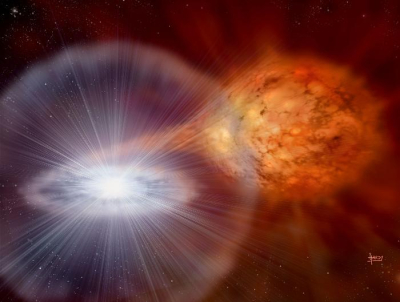Modeling the evolution of a binary system leading to a Neutron Star collision
As a star evolves, depleting the hydrogen in its nucleus and becoming a supergiant, its size may increase by more than 500 times. If the star is in a binary system it enters the so-called common envelope phase, in which the evolved star engulfs its companion upon expansion. During this phase orbital kinetic energy of the inspiraling companion is converted to kinetic energy of the envelope of the giant star and it is a critical evolutionary stage forming short-period, compact-object binary systems, such as coalescing double compact objects, X-ray binaries, and cataclysmic variables.
An international team lead by Prof. Anastasios Fragos at the Univ. of Geneva, Switzerland in which Jeff Andrews and Andreas Zezas of IA-FORTH are also members, performed the first detailed hydrodynamical modeling of the inspiral of a 1.4 M⊙ neutron star (NS) inside the envelope of a 12 M⊙ red supergiant star. Their numerical work enables the self-consistent calculation of the drag force experienced by the NS and the back-reaction onto the expanding envelope as the NS spirals in.

They find that nearly all of the hydrogen envelope escapes, expanding to very large radii (∼100 Astronomical Units, that is the distance between the Earth and the Sun) where it forms an optically thick envelope with temperatures low enough that dust formation occurs. The orbit of the NS is simulated until only 0.8 M⊙ of the hydrogen envelope remains around the giant star’s core. Their numerical results suggest that the inspiral of the NS will continue until another ≈0.3M⊙ are removed, at which point the remaining envelope of the giant star will retract.
Upon separation, a phase of dynamically stable mass transfer onto the NS accretor is likely to ensue, which may be observable as an ultraluminous X-ray source.
The resulting binary, comprised of a detached 2.6 M⊙ helium star and an NS with a separation of 3.3-5.7 R⊙, is expected to evolve into a merging double neutron-star, analogous to those recently detected as sources of gravitational waves by LIGO/Virgo.
Article: A. Fragos, J. Andrews, E. Ramirez-Ruiz, G. Meynet, V. Kalogera, R.E. Taam, A. Zezas "The Complete Evolution of a Neutron-star Binary through a Common Envelope Phase Using 1D Hydrodynamic Simulations", The Astrophysical Journal Letters, Vol. 883, 45 (2019)
